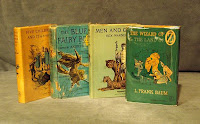The Haunted Looking Glass was published in 1959 by the Looking Glass Library and showcases Edward Gorey's artistic talent at the peak of his game.
 In addition to choosing which ghost stories to include in this collection, Gorey provided an absolutely stunning full page illustration for each tale. These drawings exemplify Mr. Gorey's fully formed and considerable talent for illustration. Each title page drawing is dripping with atmosphere and suspense, bringing the story to life for the reader.
In addition to choosing which ghost stories to include in this collection, Gorey provided an absolutely stunning full page illustration for each tale. These drawings exemplify Mr. Gorey's fully formed and considerable talent for illustration. Each title page drawing is dripping with atmosphere and suspense, bringing the story to life for the reader.In 1995, with his home literally falling about his head and in need of immediate repair, Mr. Gorey decided to sell some of his original illustration holdings through Gotham Book Mart. One of the suites of illustrations he offered for sale was the artwork from The Haunted Looking Glass.
 At the time I was only able to purchase one piece from this set and had to make my decision quickly because many collectors were lining up to get at the artwork! I decided to purchase the illustration for The Monkey's Paw by W. W. Jacobs, which is arguably the most "classic" story in the book.
At the time I was only able to purchase one piece from this set and had to make my decision quickly because many collectors were lining up to get at the artwork! I decided to purchase the illustration for The Monkey's Paw by W. W. Jacobs, which is arguably the most "classic" story in the book.This beautiful drawing shows how far Mr. Gorey progressed artistically in the six years since he started working as a professional artist. Using only pen and ink on white paper, the variety in the line work provides a tense, moody backdrop for the scene. The theatrical effect of the shriveled monkey's paw on the table is accentuated by the glow on the faces and the darkening of the chairs around the circle of onlookers. This subtle use of light and shadow makes the tiny dreaded object the center of attention.
Along with my first edition of The Haunted Looking Glass, this illustration was displayed as part of the exhibit "Reading and Collecting Books, Minnesota Book Collectors" which was held from June 8 to August 11, 1996 in the Cargill Gallery at the Minneapolis Institute of Arts.

































